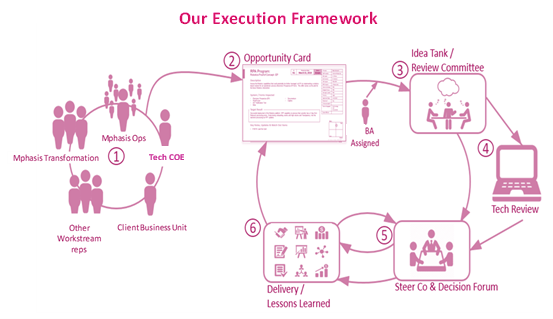Businesses have been under pressure to go digital for a few years now. COVID-19 has lent this requirement urgency and immediacy. The only way companies can survive the disruption the pandemic is causing is for their employees to be available 24/7 remotely while ensuring timely, low-touch or no-touch safe deliveries of goods and services to customers.
These new requirements have contributed to further accelerating the adoption of Digital Transformation across industries. This has, in turn, led to a drastic change in the business operations landscape, which is evolving at a faster pace than thought imaginable. In this context, the need for a sustainable digital transformation Center of Excellence (or CoE) and a replicable execution strategy have become not just Critical-to-Success but fundamental for everyday business operations.
At Mphasis, we Lead the Change in assisting our clients on their DX journeys by implementing our NextOps, where we use our Front2Back™ transformation approach and leverage state-of-the-art reference frameworks, IP and agile transformation capabilities for fast results that compound over time.
However, an effective transformation CoE does not happen overnight. For an organization, having the right cultural foundation with the correct cultural tenets is critical to both innovate and execute.
Breaking away from siloes
One way we attempt to do this well is by organizing ourselves into Tribes and Squads. This ensures we do not operate as a siloed organization. Doing so, especially in these dynamic times, is critical to success as it provides agility and flexibility and helps us provide clients with the talent they require at the right speed of implementation. This is why we say Engineering is in our DNA.
Consider, for example, a major transformation program we were assigned by a large US-based wealth management organization. We needed RPA and tech architects, business analysts, and E2E PM roles to undertake onsite and offshore Design Development and implementation over a 3-6 months E2E cycle. Our structured NextOps Talent metamorphosis program yielded up to 60-70 percent of these positions and helped deliver customer outcomes on time.
Leveraging this modular structure has also been key for program success when working across other digital technology levers in diverse tech landscapes, including Low Code No Code, Robotic Process Automation, AI-Cognitive Data extraction, and Data Analytics, among others.
But none of this is to suggest that good results are obtainable overnight. In our experience it takes an average of two-three years to achieve a breakthrough, but the outcomes are positive, robust, and compounded.
Rooting for a robust change management strategy
However, robust digital transformation outcomes are achieved only when every DX program is rooted in an effective change management strategy and headed by visionary leaders with dynamic, multi-domain industry exposure whose experience and knowhow helps build a successful digital transformation CoE. This is important because the objective of any DX program is to effect change at the client’s and their customer’s end.
Pushing for a bite-sized execution plan
The other key component of a NextOps DX plan is its execution strategy. This should be well thought out with clearly defined roles, responsibilities, dependencies, communication plans, and governance processes to be replicable and reproducible.
Depending upon the scale and size of the engagement, the entire execution plan should be “bite-sized”: broken up into different waves, phases, and pods for ease of execution and better control. This ensures that the execution follows a bottom-up approach with greater focus and agility.
To facilitate this kind of execution we pay close attention to our process improvement frameworks to optimize both business and processes. For this, we focus on leading by design through process walkthroughs while keeping the customer always front and center. It is their objectives that need to lead any NextOps DX program.
The execution approach is always multi-dimensional by plan and typically follows the traditional Plan-Do-Check-Act (PDCA) cycle for process improvement, although with required variability depending on the different requirements and contexts at hand.
The following figure is a snapshot of the typical framework we adopt for execution:

This framework enables a continuous assessment of opportunities, helps expedite sign-off by clients, and ensures speedy execution. In our experience, when this framework is followed, our teams can transition from six-seven suggestions of DX programs to three - or four approved ideas without encountering a problem with sponsorship.
However, these outcomes depend on a commonly agreed roadmap/matrix with a shared prioritization of transformation initiatives/objectives. The ultimate objective is to ensure businesses get a robust return on investment, along with the security of a long-term construct. To ensure these are met, Mphasis deploys its zero-cost transformation archetype by leveraging innovative, outcome-oriented models and self-funded transformation initiatives.
Some of the key wins achieved following our NextOps program include industry-beating growth rates, large wins in the NextOps space, and new business driven by our Digital and F2B-led propositions. For clients, our program has helped align their operations with CXO-level business objectives, including net promoter scores, Advisor/User Experience CSAT, and time-to-market performance indicators, among other parameters.
If you are embarking on a DX journey be sure to consider the unique advantages our NextOps solution offers to help you stay ahead and lead the change.


